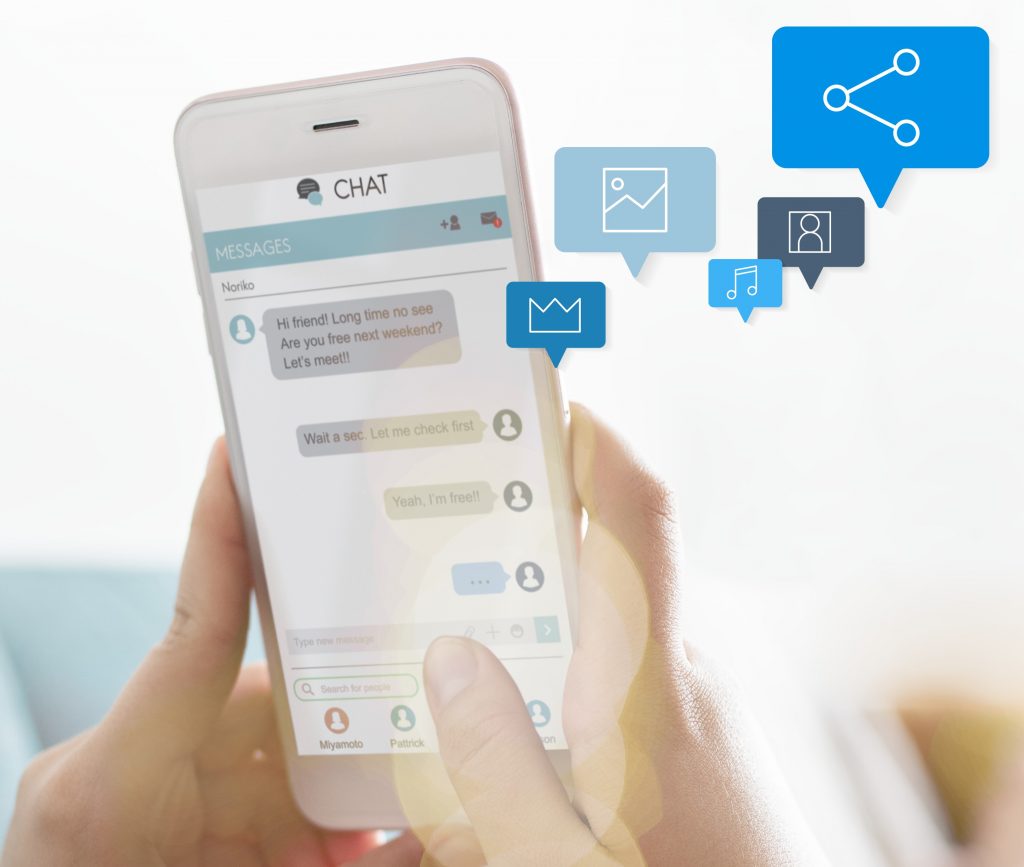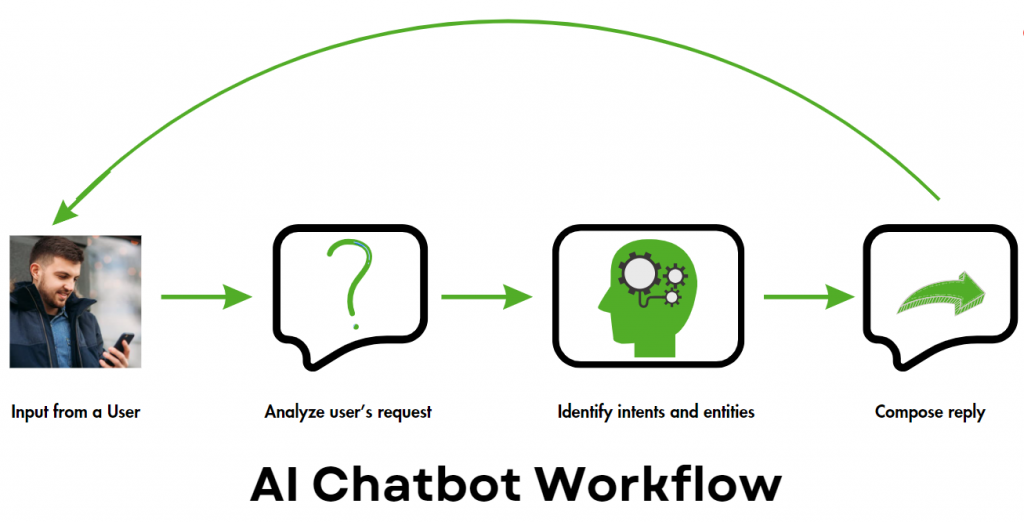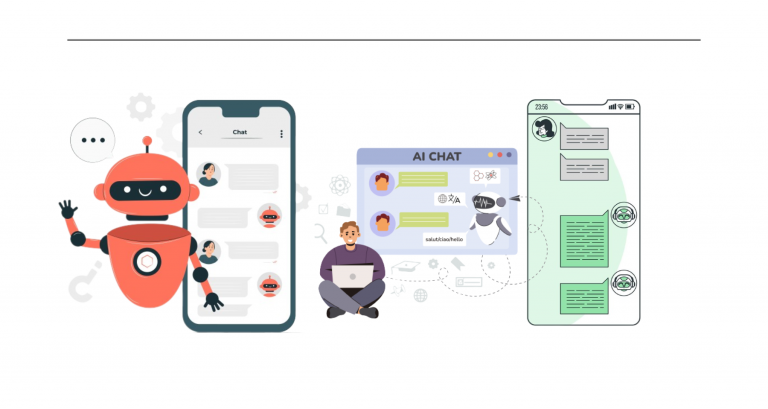Artificial Intelligence chatbot are the next big thing for businesses. Unlike traditional chatbots, AI chatbot use large language models (LLMs) to understand and generate natural language, without the need for tedious and costly natural language understanding (NLU) development. This makes them more effective, versatile, and easy to deploy.
Table of Contents
In this guide, you will learn the basics of AI chatbot, how they work behind the scenes, and how they can help you automate and improve your business processes, such as customer service, sales, or marketing. You will also discover how VIVI leverages these technologies to create AI webchat and voice chat solutions that meet the needs and preferences of your customers.
Voice Assistants are now globally socialized! The next era of voice engagement is conversational & chat AI assistants. There have been recent technological changes to processing, speech recognition, natural voice, smart speakers and internet bandwidth that have made them more accurate and enjoyable solutions.

What are artificial intelligence chatbots?
If you surf various company websites, you will often see a chat icon in the bottom right corner. Once you click on the button or the icon there, one of several things may happen. In some scenarios, you will be presented with a series of options like a decision tree, such as product names, quantity, size, etc.
Once you make a selection, additional sub-menus may ask you to make more selections, and at some point, it will ask for your contact information. These widgets are called chatbots but they are restricted to a very specific flow and mostly focused on information gathering.
Another variant of these chatbots would connect you to a live person. This person would talk to you and address your issues, concerns, or queries through a chat conversation. These are chat tools pushed to a website, but there is nothing automated in those so they are not chatbots.
A third breed that’s rapidly becoming popular is the artificial intelligence chatbots, which would talk to you just like a human, without putting you into constraints of menu selections. It will address your issues and concerns, and collect your contact information in order to reach back to you, but not involve a human. Clearly, this offers a huge advantage to the enterprise that wishes to scale rapidly but cannot add expensive staff quickly.
Artificial intelligence chatbots are not just limited to websites. They exist on phone lines. With the advent of highly accurate speech-to-text or automatic speech recognition (ASR) and neural speech synthesis, it’s possible to not even realize that you are talking to an AI chatbot over the phone. They also exist on messaging applications such as Messenger, Skype, WhatsApp, and Telegram. Let’s take a little deeper dive into the building blocks of these artificial intelligence chatbots.
Here are some examples of artificial intelligence chatbots in action. They can be used to discover products, solutions or services, make connections to the right people, automate business processes, and standardise an optimized experience to improve the customer experience.
NLU, NLG, and LLM
AI chatbots are trained to perform human-like conversations using a text-processing technique called natural language processing(NLP). NLP allow the AI chatbot to understand the user queries or concerns.
Classical NLP would categorize the user input into a list of intents and entities. These intents and entities may then be used to create database queries or knowledgebase queries, in order to generate the components that would then contribute to the response. These query responses would then be passed to a Natural Language Generation(NLG) module that would format the output into plain text, suitable for human consumption.
The recent approach of using Large Language Models (LLMs) is both simpler as well as more complex. OpenAI’s chatGPT has made this approach very popular. However, there are challenges to using it. First, let’s describe the approach. Large Language Models can be tuned to answer questions. In this scenario, the transformer models learn to answer general questions.
The finetuning is performed using large datasets, and human feedback in terms of answer quality ranks is used to finetune this AI chat model. Eventually, the input to this larger neural network is text, and the output is also text. These models perform amazingly well for general conversations. However, the objective of putting chat on a business website is the answer questions about the business and maybe automatically perform certain tasks, or generate leads, and not to engage in general conversations.
Challenges for using Large Language Models in AI chatbots
There are a few challenges with using these LLMs for your own business applications for artificial intelligence chatbots.
- They know too much about the outside world. If you are in the business of selling pancakes, you probably don’t want to be talking about the mechanics of flying an aeroplane. A focus on your business is needed.
- They know too little about your business. Maybe your product or service has certain specific features that are unique. If the artificial intelligence chatbot isn’t aware of those, then it won’t be able to talk about them.
- They hallucinate. Often when asked about a specific person, product or solution, instead of addressing that, the answer would become generic and more often than not, incorrect.
- They are bad at leading the conversation by asking their own questions.
To address these issues, it’s important to control the behaviour of LLMs and tune them to suit your requirements. This is the holy grail of active research and development, and numerous techniques are already prevalent in the community such as model fine-tuning with techniques such as LORA, prompt engineering, prompt middleware, adversarial training, differential privacy and federated training, each one of these could justify a full-length article in their own right.
Since LLMs take text and input and generate text as output, they combine the NLU, retrieval and NLG all together into a single piece. A specialized prompt middleware is the only known method for introducing database lookups and knowledge understanding into an LLM framework.
Should I deploy an AI chatbot or classical NLP-based chatbot or a Decision tree?
The choice between the classical NLP-based chatbot or the newer AI chatbots is very much dependent on your use case. The classical NLP-based chatbots can be finetuned very closely to your application.
Classical NLP-based chatbots can be very predictable, which may be a good thing if your business needs predictability and control over the flow of your application. This would allow you to ensure that certain questions always have the same answers and that certain requests made to the chatbot always lead to the same actions by the chatbot.
If you have a lot of data available from past human interactions, maybe the classical NLP bot can learn from this data, and probably they can also be backtested on this data, ensuring that your bot performs similarly to or better than humans.
Another situation where you would want to use classical NLP chatbots is where you would like to have exact control of the output text and the lingo of the bot. The LLM-based AI chatbots generate their own text, and that makes it difficult to have exact control over the vocabulary and lingo of the bot. However classical techniques allow you to have control of the exact lingo.
However, there are other situations where it probably makes more sense to deploy a LLM-based AI chatbot. If you are a small organization and have little idea how your conversations should evolve, an LLM-based artificial intelligence chatbot can be a great starting point for you. An AI chatbot can quickly learn about your business and come up with goal-driven reasonably good answers to customer queries.
This allows you to be up and running quickly and then further improve your artificial intelligence chatbot as you learn more about how your customers are interacting with the system.
A LLM-based artificial intelligence chatbot will be able to handle a wide array of situations better and therefore it’s a great way to tread into the unknown territory, where you are just enabling a new line of conversation. As the bot interacts more am more with the customers, it learns from its experience and becomes better. Best of all, it never forgets anything it learns, does not ask for a raise and is available 24×7.
Some users tend to stay with decision trees. However, decision trees tend to be unpopular amongst users as they cannot express their requirements clearly..
Artificial Intelligence chatbot helps as a business intelligence platform
Chat data is ideally stored at the backend and can provide valuable information about customer sentiment and preferences. Here are some of the analytical information you can get:
- Product and Feature mention: If you were ever worried about what other competitor products your customers are looking at, or what features matter to them the most, look for the clues in your data. Data-driven approaches can give you very quantitative estimates and take the guesswork out of the equation.
- Sentiment analysis: Generic measurement of customer sentiment and how it changes over time can help you keep track and manage new product launches and support quality for existing products.
- Drivers: Through proper setup, you can identify and quantify all the important drivers for your conversations, and use that information to further optimize the user experience.
- Topic Discovery: Discover topics that customers bring up but you could not anticipate in advance. React quickly to these new situations as you set up the feedback loop and close gaps quickly.
By hooking the artificial intelligence chatbot to your business intelligence platform, you can gather valuable intelligence that can help you manage important decisions for your products and services.
Deployment Strategy
Given the complexities of an AI bot, one could often wonder what the deployment strategy should be. If you are a beginner in the field, you are probably starting with very little information. You would not have previous conversation logs from your customers, or anything else to guide you through the process.
At this stage, maybe having an AI-based bot is the best choice for you because they are general and versatile. Even though they may not behave in the best possible manner, they would generally be very reasonable in their responses. Another option, if you can afford it would be to start with some well-trained people supporting the chat lines and logging all the conversations so that you can develop more data.
However, whatever you choose, you should probably not delay a deployment, because once you deploy, you will begin to collect data, and that data will help you further develop your strategy and improve further. This data is invaluable and no internal testing will be able to produce this data.
Once you have some history, those ideal historical conversations (maybe with some corrections) can be used as a guide to backtest your artificial intelligence chatbot. At this time leveraging a combination of LLM and NLU-based AI chat technologies will be the best for you. The system can be fine-tuned to optimize the responses to create a pleasing user experience.
VIVI the AI chatbot that adapts
VIVI refers to an AI chatbot solution from GoVivace that encompasses the ability to combine all of the technologies mentioned above, to develop solutions for a diverse set of use cases. It’s a complex platform that supports multiple technologies that can all pull together to create a pleasing customer experience. Some of those technologies are:
- Natural Language Understanding: The Natural language understanding component can identify intents, and extract important entities such as names, product names, phone numbers, email addresses, zip codes, order numbers, etc. It allows the conversation to be structured and smooth.
- LLMs: There will always be times when Natural Language understanding cannot understand what the user said. The topic is too new or something that the NLU components were never trained on that type of input. LLMs can be of great assistance to your AI chatbot at that time.
- Speech to Text and Text to Speech: To voice-enable your chatbot you would need a very accurate speech-to-text. If the speech-to-text is not accurate, a lot of time may get wasted in hiding or accounting for the inaccuracies of the system. Therefore it’s very important that the company deploying the AI chatbot has full control of the speech-to-text technology so that they can adapt to the lingo and terminology related to your industry if needed. The text-to-speech should sound very natural, for a pleasing user experience.
- Speaker Identification and Gender Identification: Just the way humans interact, they often recognize the gender of the speaker or the identity of the person on the other side and adapt the conversations accordingly. Similarly, your AI chatbot needs to be smart and avoid unnecessary explicit questions and validations where possible.
- Learning: Your AI chatbot needs to constantly learn from its conversations, adapting its response to different patterns and new situations.
Frontdeskter
If this post has motivated you, you are probably thinking how can I speed up my deployment and get something up and running quickly? One solution you should consider is the Frontdeskter. It’s a solution that can act as the receptionist for your company, answering common questions, forwarding calls to the appropriate people when needed, and always notifying you of all the activity so that nothing is ever missed.

It also acts as a chatbot on your website, collecting customer details for contact and answering common questions. A management dashboard allows you to tune its response, maintain the company directory, and access important analytics. This workflow allows you to start from scratch build the capabilities quickly, and then iteratively refine those. Any desired workflows and be incorporated into this framework.
[faq_from_sheet]

